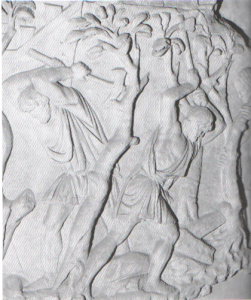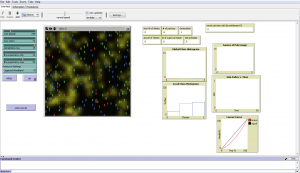In a fit of optimism, I agreed to contribute to a conference on ancient Roman economic history.
“Ancient logging? Sure, no problem” said I. Of course, there is a problem: namely, that the archaeology of logging is pretty sparse. There’s been one major work on the topic in oh, the last thirty years, more or less. Ideally, one would get out there in the landscape, looking for evidence of timber camps, weirs, sluices, slides, and other alterations to water courses, pollen analysis, impressions of wood grain and so on in Roman concrete… a great summer project, but a bit hard to do over the winter from Canada.

So instead, I decide to raise the dead (or stitch some together) and see what they could tell me, using Netlogo.
This presents certain problems. Do I try to build a simulation that handles all the various permutations of economic thought, against a background GIS with forestry data, archaeological survey data, and so on? Do I follow the example of the Artificial Anasazi?
That’s certainly one approach, and one that has produced significant insights. But see, I’m fairly simple. I can’t hold more than one or two processes in my head at any one time. Walking and chewing gum: ok, but don’t ask me to actually navigate too. So instead, my approach was to:
1. create a world with a resource.
2. allow agents to harvest that resource (they can see a certain distance within the world).
3. movement in the world consumes the resource (they all have differing metabolisms).
4. if agents consume more resource than they have on hand, they die.
Very simple. In fact, it’s not even my model, but one of the example models that comes bundled with Netlogo (‘wealth distribution‘. This model shows that the random distribution of resources in a world is sufficient to create wealth inequalities).
So I added a few more steps.
5. agents could ask for help from those in their local neighborhood (thus becoming clients).
6. helping other agents (ie, being a patron) increases prestige, which translates back into an enhanced ability to extract resources (a routine for euergetism).
7. agents with high prestige compete against each other for even more prestige, drawing on the resources of those who owe them for their earlier help.
These three steps, in a nutshell, are the essence of patron-client relationships. And in this way, I now had a laboratory for exploring different understandings of the Roman economy. By creating pre-sets for the environment, I can simulate many different kinds of resources. I can bolt on trade mechanisms. Even better, I can release this model to the wider world, and other folks can do the same thing.

You’ll notice that by asking for help, and by drawing on clients, the model generates a social network with every run. This I think is the most important part of what’s going on. I can compare my social networks, and their statistics, with networks drawn from the archaeology, from maker’s marks, from documents, from inscriptions, from prosopography. Where there are good parallels, I can tune my model to explore further, since ‘vision’ really means, ‘knowledge of the world’ and metabolism can stand in for a whole host of consumption issues, transport issues and so on. By fiddling with the model where these parallels are tight, I learn something new about the ancient situation…. but remember: I’m not simulating antiquity. I’m modeling in a rigorous way (it has to be expressible in code) what I believe about the past. In this case, about how patronage intersects with the physical world.
Like the petri dish is to biology, agent modeling can be for history. Stay tuned.
(photo: Promotional photo of Boris Karloff from The Bride of Frankenstein as Frankenstein’s monster. 1931 Universal Studios)

I think the idea of your Roman Logging Simulation is really interesting, especially in the context of the ongoing discussion of the value of quasi-historical history simulations like Civilization that surfaces from time to time on Play the Past. While it definitely produces a different kind of knowledge than examining concrete, it sounds like a good way to find insights into less tangible aspects of the Roman logging industry.
I find the social aspect of your model to be particularly interesting. I do a lot of work with Actor-Network Theory, which deals a lot with the social aspects of technology and technical development. If we look at the Roman logging industry as part of a large socio-technical system, its interesting to see how the process of logging makes some agents into key “Patron” nodes in the network and how that in turn affects the process of logging. It would be interesting to see if the model could be expanded to deal with other economic aspects, such as trade between patrons, or changes in supply and demand.
Hi Peter,
Thank you for the comments. Once I’ve commented out the code, and cleaned things up a bit, I’ll be posting the model where others can tinker with it. ideally, folks will expand it to allow just those kinds of interactions.